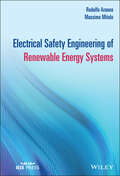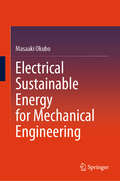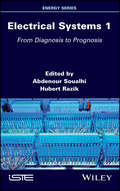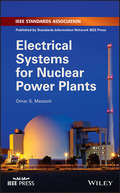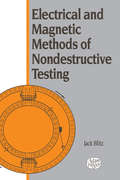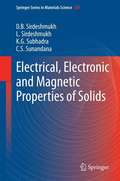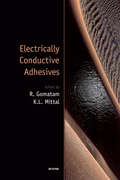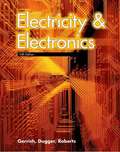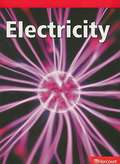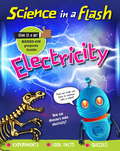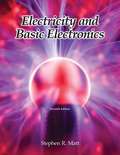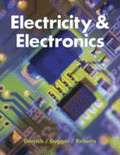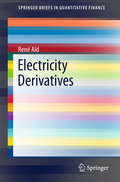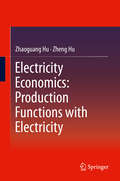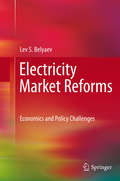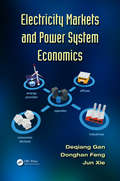- Table View
- List View
Electrical Safety Engineering of Renewable Energy Systems (IEEE Press)
by Rodolfo Araneo Massimo MitoloElectrical Safety Engineering of Renewable Energy Systems A reference to designing and developing electrical systems connected to renewable energies Electrical Safety Engineering of Renewable Energy Systems is an authoritative text that offers an in-depth exploration to the safety challenges of renewable systems. The authors—noted experts on the topic—cover a wide-range of renewable systems including photovoltaic, wind, and cogeneration and propose a safety-by-design approach. The book clearly illustrates safe behavior in complex real-world renewable energy systems using practical approaches. The book contains a review of the foundational electrical engineering topics and highlights how safety engineering links to the renewable energies. Designed as an accessible resource, the text discusses the most relevant and current topics supported by rigorous analytical, theoretical and numerical analyses. The authors also provide guidelines for readers interested in practical applications. This important book: Reviews of the major electrical engineering topics Shows how safety engineering links to the renewable energies Discusses the most relevant current topics in the field Provides solid theoretical and numerical explanations Written for students and professional electrical engineers, Electrical Safety Engineering of Renewable Energy Systems explores the safety challenges of renewable systems and proposes a safety-by-design approach, which is currently missing in current literature.
Electrical Sustainable Energy for Mechanical Engineering
by Masaaki OkuboThis book describes fundamentals and applications on electrical sustainable energy for Mechanical Engineering. The main objective of this book is to provide readers with an easy-to-understand resource on the foundations and application of electrical sustainable energy. This book was specifically crafted with the intention to serve as a resource for students in the third year through graduate school, particularly in departments other than electrical engineering such as mechanical engineering departments at universities. The aim is to provide foundational knowledge on sustainable electrical energy and energy conversion principles. The topics addressed are those which the author found beneficial in the pursuit of mechanical engineering research and are related to sustainable electrical engineering. It is designed to be covered within a semester of 15 weeks (90 minutes per week), structured into nine chapters. Specifically, it is suggested that chapters 1 and 2 be taught over 4 weeks, chapters 4 to 7 over 6 weeks, and chapters 8 and 9 across 5 weeks. Furthermore, each chapter has comprehensive exercise problems and is projected to cover approximately eight problems in two weeks. These exercises can either be conducted as in-class integrative practice or assigned as weekly homework tasks, with the intention of nurturing problem-solving capabilities in students.
Electrical Systems 1: From Diagnosis to Prognosis
by Hubert Razik Abdenour SoualhiMethods of diagnosis and prognosis play a key role in the reliability and safety of industrial systems. Failure diagnosis requires the use of suitable sensors, which provide signals that are processed to monitor features (health indicators) for defects. These features are required to distinguish between operating states, in order to inform the operator of the severity level, or even the type, of a failure. Prognosis is defined as the estimation of a system's lifespan, including how long remains and how long has passed. It also encompasses the prediction of impending failures. This is a challenge that many researchers are currently trying to address. Electrical Systems, a book in two volumes, informs readers of the theoretical solutions to this problem, and the results obtained in several laboratories in France, Spain and further afield. To this end, many researchers from the scientific community have contributed to this book to share their research results.
Electrical Systems for Nuclear Power Plants
by Dr Omar S. MazzoniCovers all aspects of electrical systems for nuclear power plants written by an authority in the field Based on author Omar Mazzoni’s notes for a graduate level course he taught in Electrical Engineering, this book discusses all aspects of electrical systems for nuclear power plants, making reference to IEEE nuclear standards and regulatory documents. It covers such important topics as the requirements for equipment qualification, acceptance testing, periodic surveillance, and operational issues. It also provides excellent guidance for students in understanding the basis of nuclear plant electrical systems, the industry standards that are applicable, and the Nuclear Regulatory Commission’ rules for designing and operating nuclear plants. Electrical Systems for Nuclear Power Plants offers in-depth chapters covering: elements of a power system; special regulations and requirements; unique requirements of a Class 1E power system; nuclear plants containment electrical penetration assemblies; on-site emergency AC sources; on-site emergency DC sources; protective relaying; interface of the nuclear plant with the grid; station blackout (SBO) issues and regulations; review of electric power calculations; equipment aging and decommissioning; and electrical and control systems inspections. This valuable resource: Evaluates industry standards and their relationship to federal regulations Discusses Class 1E equipment, emergency generation, the single failure criterion, plant life, and plant inspection Includes exercise problems for each chapter Electrical Systems for Nuclear Power Plants is an ideal text for instructors and students in electrical power courses, as well as for engineers active in operating nuclear power plants.
Electrical Transmission Systems and Smart Grids
by Miroslav M. BegovicElectric transmission networks are among the largest human-made engineering systems: For example, the transmission network in the United States covers over 300,000 km of lines and is served by 500 companies (electric utilities). In sharp contrast to the very incremental developments of the last century, transmission and control technologies experienced a major breakthrough at the beginning of the 21st century. The rapid growth of new energy generation technologies (renewables), significant advances in information processing applied to system monitoring, planning, operation, control, and protection, radical changes in distribution networks, and key shifts in end user behavior (advanced metering and control of demand response) have combined to produce the modern integrated electrical infrastructure commonly referred to as the smart grid. Featuring state-of-the-art, peer-reviewed entries from the Encyclopedia of Sustainability Science and Technology, this book provides a detailed introduction to select key topics which span energy technology, engineering, and urban planning. Worldwide experts discuss the integration of electric energy infrastructure into the broader critical infrastructures of the modern world and their various interdependencies. Dedicated chapters cover specific topics ranging from underground transmission and distribution, to energy and water interdependence, and their implications for urban areas. Coverage also includes the key role of new policy initiatives as catalysts of change.
Electrical Wizard: How Nikola Tesla Lit Up The World (Candlewick Biographies Series)
by Elizabeth Rusch Oliver DominguezWhen a Serbian boy named Nikola Tesla was three, he stroked his cat and was enchanted by the electrical sparks. By the time he was a teenager, he had made a vow: Someday I will turn the power of Niagara Falls into electricity. Here is the story of the ambitious young man who brought life-changing ideas to America, despite the obstructive efforts of his hero-turned-rival, Thomas Edison. From using alternating current to light up the Chicago World's Fair to harnessing Niagara to electrify New York City and beyond, Nikola Tesla was a revolutionary ahead of his time. Remote controls, fluorescent lights, X-rays, speedometers, cell phones, even the radio -- all resulted from Nikola Tesla's inventions. Established biographer Elizabeth Rusch sheds light on this extraordinary figure, while fine artist Oliver Dominguez brings his life and inventions to vivid color. Back matter includes additional information about Tesla, scientific notes and explanations, source notes, a bibliography, and suggestions for further reading.
Electrical and Magnetic Methods of Nondestructive Testing
by Jack BlitzElectrical and Magnetic Methods of Nondestructive Testing presents a comprehensive account of the electrical and magnetic methods of nondestructive testing (NDT). The book begins with a discussion of the requirements for NDT and the criteria for the choice of a given method, followed by a summary of the general theory relating to electrical and magnetic testing techniques. Subsequent chapters discuss specific methods, including eddy current and flux-leakage techniques and microwave and potential drop methods. The appendix provides some useful programs for eddy current impedance analyses. These programs are in BASIC and can be run on PCs.
Electrical and Optical Polymer Systems: Fundamentals: Methods, and Applications (Plastics Engineering)
by Donald L. Wise"Offers background information, methods of characterization, and applications for electrical and optical polymers, including biopolymers, and tutorial sections that explain how to use the techniques."
Electrical and Optoelectronic Properties of the Nanodevices Composed of Two-Dimensional Materials: Graphene and Molybdenum (IV) Disulfide (Springer Theses)
by Cheng-Hua LiuThis thesis focuses on the transport and magneto-transport properties of graphene p-n-p junctions, such as the pronounced quantum Hall effect, a well-defined plateau–plateau transition point, and scaling behavior. In addition, it demonstrates persistent photoconductivity (PPC) in the monolayer MoS2 devices, an effect that can be attributed to random localized potential fluctuations in the devices. Further, it studies scaling behavior at zeroth Landau level and high performance of fractional values of quantum Hall plateaus in these graphene p-n-p devices. Moreover, it demonstrates a unique and efficient means of controlling the PPC effect in monolayer MoS2. This PPC effect may offer novel functionalities for MoS2-based optoelectronic applications in the future.
Electrical, Electronic and Magnetic Properties of Solids
by D. B. Sirdeshmukh L. Sirdeshmukh K. G. Subhadra C. S. SunandanaThis book about electrical, electronic and magnetic properties of solids gives guidance to understand the electrical conduction processes and magnetism in a whole range of solids: ionic solids, metals, semiconductors, fast-ion conductors and superconductors. The experimental discussion is enriched by related theories like the free electron theory and the band theory of solids. A large spectrum of topics is presented in this book: Hall effect, magnetoresistance, physics of semiconductors, functioning of semiconductor devices, fast-ion conduction, classical and modern aspects of superconductivity. The book explains the magnetic properties of solids and theoretical and experimental aspects of the various manifestations of magnetism, dia-, para-, ferro-, antiferro- and ferri-magnetism. The consideration of magnetic symmetry, magnetic structures and their experimental determination completes the spectrum of the book. Theories, techniques and applications of NMR and ESR complete the analytical spectrum presented. Some of these topics are not represented in standard books. Each topic is thoroughly treated. There are historical remarks and a discussion of the role of symmetry in the book. The book lays great emphasis on principles and concepts and is written in a comprehensive way. It contains much new information. This book complements an earlier book by the same authors (Atomistic properties of solids - Springer, 2011).
Electrically Conductive Adhesives
by Kash L. Mittal Rajesh GomatamWith all the environmental concerns and constraints today and stricter future regulations, there is a patent need to replace materials noxious to the environment by environmentally-friendly alternatives. Electrically conductive adhesives (ECAs) are one such example. ECAs offer an excellent alternative to lead-solder interconnects for microelectroni
Electrically Conductive Membrane Materials and Systems: Fouling Mitigation For Desalination and Water Treatment
by Nidal Hilal Farah Ahmed Raed HashaikehElectrically Conductive Membrane Materials and Systems offers in-depth insight into the transformative role of electrically conductive materials in membrane separation processes for desalination and water treatment. The book focuses on the intelligent design of conductive membranes and systems, fouling and related phenomena, fouling control using electrically conductive materials, and electrically tunable membrane systems for microfiltration, ultrafiltration, nanofiltration, reverse osmosis, and membrane distillation. With rising concerns around inaccessibility to freshwater and the ever increasing threats of population growth, climate change, and urban development, the book brings electrically conducting materials to the forefront of membrane separation technology with an emphasis on their role in the mitigation of fouling and related phenomena. Electrically conducting materials expand the versatility of membrane technology and ultimately improve access to safe water. The book is important reading for scientists, engineers, entrepreneurs, and enthusiasts from the water industry who seek to familiarize themselves with a groundbreaking area of study within modern desalination and water treatment. • Explores novel membrane materials and systems from preparation methods, materials selection, and their application in monitoring, fouling control, and performance enhancement. • Examines the mechanism of fouling prevention and cleaning in various electrically conductive materials. • Evaluates the scalability of antifouling materials and coatings, as well as electrically enhanced processes for monitoring and control in membrane separation technology. • Assesses advantages and limitations of applying electrically conductive membrane systems to fouling control for specific water treatment applications. • Provides a critical review of scientific literature in the specialized area of electrical conductive materials and systems for membrane technology.
Electrically Driven Quantum Dot Based Single-Photon Sources: Modeling and Simulation (Springer Theses)
by Markus KantnerSemiconductor quantum optics is on the verge of moving from the lab to real world applications. When stepping from basic research to new technologies, device engineers will need new simulation tools for the design and optimization of quantum light sources, which combine classical device physics with cavity quantum electrodynamics. This thesis aims to provide a holistic description of single-photon emitting diodes by bridging the gap between microscopic and macroscopic modeling approaches. The central result is a novel hybrid quantum-classical model system that self-consistently couples semi-classical carrier transport theory with open quantum many-body systems. This allows for a comprehensive description of quantum light emitting diodes on multiple scales: It enables the calculation of the quantum optical figures of merit together with the simulation of the spatially resolved current flow in complex, multi-dimensional semiconductor device geometries out of one box. The hybrid system is shown to be consistent with fundamental laws of (non-)equilibrium thermodynamics and is demonstrated by numerical simulations of realistic devices.
Electricity & Electronics
by Richard M. Roberts Howard H. Gerrish William E. Dugger Jr.Textbook on the fundamentals for technical school students. No bibliography.
Electricity (Merit Badge Series)
by Boy Scouts of AmericaThis book introduces scouts to the generation of and uses of electricity.
Electricity (Science in a Flash #23)
by Georgia Amson-BradshawunfortunatelyWhat's the buzz about electricity? All bright sparks need to read this book to discover the shocking facts about electricity, as well as all about batteries, circuits and conductors.This essential KS2 series for children aged 7 and up covers all the key science topics in energetic, quick-fire way, aiding clear comprehension by getting straight to the point! Each spread starts with a 'flash' or headline, summing-up succinctly the science information to follow. Attractive and light-hearted illustration visually conveys the information, adding depth and detail to engage children. Also includes fun jokes and cartoons to keep even the most reluctant readers entertained.
Electricity And Basic Electronics
by Stephen R. MattElectricity and Basic Electronics teaches basic theory and fundamentals and is a starting point for careers in electronics. The text is clearly written and highly illustrated, making it easy for beginners to understand. Numerous examples walk students step-by-step through circuit analysis where applicable. The Practical Application and Project feature covers topics such as breadboarding, soldering, and reading voltage on an oscilloscope. There are 16 practical applications in all. The Project features, 28 in all, allow students to build items such as a continuity tester, blown fuse indicator, and power supply. Projects typically include a schematic, a picture of the finished product, and a procedure for assembling the project. A new Math Focus feature provides students with a quick review of the basic math skills they need to understand the topic at hand. Math topics covered are exponents, scientific notation, metric and electrical prefixes, order of operations, algebraic equations, adding fractions, rations and proportions, and square roots. A new chapter called “Energy Conservation” covers ways to conserve energy and alternative forms of energy. Geothermal systems, photovoltaics, and wind turbines are just some of the topics covered.
Electricity And Electronics
by Richard M. Roberts Howard H. Gerrish William DuggerTextbook on the fundamentals for technical school students. No bibliography.
Electricity Derivatives
by René AïdOffering a concise but complete survey of the common features of the microstructure of electricity markets, this book describes the state of the art in the different proposed electricity price models for pricing derivatives and in the numerical methods used to price and hedge the most prominent derivatives in electricity markets, namely power plants and swings. The mathematical content of the book has intentionally been made light in order to concentrate on the main subject matter, avoiding fastidious computations. Wherever possible, the models are illustrated by diagrams. The book should allow prospective researchers in the field of electricity derivatives to focus on the actual difficulties associated with the subject. It should also offer a brief but exhaustive overview of the latest techniques used by financial engineers in energy utilities and energy trading desks.
Electricity Economics: Production Functions with Electricity
by Zhaoguang Hu Zheng HuElectricity Economics: Production Functions with Electricity studies the production output from analyzing patterns of electricity consumption. Since electricity data can be used to measure scenarios of economic performance due to its accuracy and reliability, it could therefore also be used to help scholars explore new research frontiers that directly and indirectly benefits human society. Our research initially explores a similar pattern to substitute the Cobb-Douglas function with the production function with electricity to track and forecast economic activities. The book systematically introduces the theoretical frameworks and mathematical models of economics from the perspective of electricity consumption. The E-GDP functions are presented for case studies of more than 20 developed and developing countries. These functions also demonstrate substantial similarities between human DNA and production functions with electricity in terms of four major characteristics, namely replication, mutation, uniqueness, and evolution. Furthermore, the book includes extensive data and case studies on the U. S. , China, Japan, etc. It is intended for scientists, engineers, financial professionals, policy makers, consultants, and anyone else with a desire to study electricity economics as well as related applications. Dr. Zhaoguang Hu is the vice president and chief energy specialist at the State Grid Energy Research Institute, China. Zheng Hu is a PhD candidate at the Center for Energy and Environmental Policy, University of Delaware, USA.
Electricity Market Reforms
by Lev S. BelyaevWith the global demand for energy skyrocketing, over the past twenty years many countries have restructured their electric power industries, typically moving from a regulated monopoly to a competitive market structure. The results of these reforms vary significantly from country to country depending on the market organization model and national conditions. This book examines the restructuring in both developed and developing nations, with particular focus on the United States, Great Britain, China, and Russia, and addresses the problems arising from these transitions. The book also contains a comprehensive analysis of different electricity market models and their compatibility with the properties of electric power systems and country conditions. As the most thorough and up to date analysis of the theory and practical experience of electricity deregulation, this book is a must-read for academics, students and researchers with an interest in electric power industry restructuring. It also has direct relevance for engineers, regulators and other decision makers in companies and governmental agencies concerned with energy issues.
Electricity Markets and Power System Economics
by Deqiang Gan Donghan Feng Jun XieAfter the first power plant in history was commissioned for commercial operation by Thomas Edison on Pearl Street in New York in 1882, electricity was sold as a consumer product at market prices. After a period of rapid development, electricity had become such a fundamental product that regulation was believed to be necessary. Since then, the power
